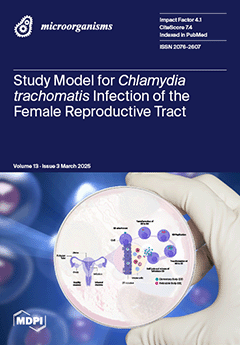Crude oil and its derivates are among the most important environmental pollutants, where
P. aeruginosa strains producing AlkB1 and AlkB2 alkane hydroxylases are often involved in their biodegradation. The aim of this study was to analyze antibiotic resistance and virulence determinants of a
[...] Read more.
Crude oil and its derivates are among the most important environmental pollutants, where
P. aeruginosa strains producing AlkB1 and AlkB2 alkane hydroxylases are often involved in their biodegradation. The aim of this study was to analyze antibiotic resistance and virulence determinants of a
P. aeruginosa isolate cultured from a hydrocarbon-contaminated soil sample from Ogoniland, Nigeria, and to compare its characteristics with
P. aeruginosa isolates cultured worldwide from hydrocarbon-contaminated environments or from clinical samples. Using the ResFinder reference database, a
catB7 chloramphenicol acetyltransferase gene, an
ampC-type PDC β-lactamase gene, and an OXA-50 type β-lactamase gene were identified in all
P. aeruginosa strains analyzed in this study. In some of these
P. aeruginosa strains, loss-of-function mutations were detected in the regulatory genes
mexR,
nalC, or
nalD, predicting an efflux-mediated acquired antibiotic-resistance mechanism. Several
P. aeruginosa sequence types that were associated with oil-contaminated environments have also been cultured from human clinical samples worldwide, including sequence types ST532, ST267, ST244, and ST1503. Our findings also indicate that environmental
P. aeruginosa may serve as the source of human infections, warranting further studies from a One Health perspective about the application of
P. aeruginosa for the in situ bioremediation of hydrocarbon-contaminated sites.
Full article






